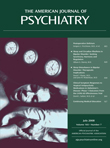Art as a Portal Into the Minds of Those With Mental Illness
Whether mental illness spurs creativity has long been debated. Regardless of whether it does or not, art is a physical representation of thoughts and emotions that are otherwise not easily conveyed by other means, and thus it is a potential portal into the minds of mentally ill people (1) . The American Visionary Art Museum (http://www.avam.org) is not a typical art museum. Located in Federal Hill near the Inner Harbor of Baltimore, the museum contains works by self-taught artists, each with a story to tell through his or her creations. A requirement for exhibition is that the artist has not had formal training. Many of these artists have mental illnesses that have required prolonged institutional care at some point in their lives.
Each artist has a small biography printed on the wall next to the featured productions to allow viewers a glimpse into the backgrounds and lives of these artists, their hardships, inspiration, and motivation for creating art. The work shown here is an example of a “quintessential visionary artist,” who was diagnosed with schizophrenia in his early 20s (2) . Despite his diagnosis, Paul Darmafall was considered an internationally renowned folk artist who presented glass-encrusted “signs” with loosely associated and cryptic messages (2) . “I stand to be corrected,” “fresh air cure,” and other writings refer to his fear of electricity and hatred of air conditioning (3) . He described himself as a “Yankee Doodle Dandy” and is best known for collages depicting early presidents and other patriotic symbols (4) .

Figure 1. This glass-encrusted “sign” is one of many created by Paul Darmafall, also known as “The Baltimore Glassman.” The collage of George Washington is prototypical of Darmafall’s work exhibiting patriotic images coupled with messages communicating his unique ideas.
The main building of the American Visionary Art Museum is a visual spectacle of mirrored mosaics complementing the curvilinear architecture. A giant spiral staircase flanked with more works allows visitors to explore the various levels and gallery rooms. Creative people are said to be more open to environmental stimuli (5) . The museum captures that concept by creating an atmosphere of artful overstimulation that is reflected in its mirrored walls, moving sculptures, and open floor plan.
1. Jamison KR: Touched With Fire: Manic-Depressive Illness and the Artistic Temperament. New York, Free Press, 2006Google Scholar
2. Oldham N: Signs - and - Wonders: The - World - of - the - Baltimore - Glassman. City Paper, June 26, 2002 (http://www.citypaper.com/news/story.asp?id=3416Google Scholar
3. The Baltimore Glassman—Paul Darmafall 1925–2003. Detour Art (http://detour.webdatabases.net/artist_detail.html?ArtistID=10216&ArtID=10216)Google Scholar
4. Rosenak C, Rosenak J: Contemporary American Folk Art: A Collector’s Guide. New York, Abbeville Press, 1996, pp 37–38Google Scholar
5. Carson SH, Peterson JB, Higgins DM: Decreased latent inhibition is associated with increased creative achievement in high-functioning individuals. J Pers Soc Psychol 2003; 85:499–506Google Scholar



